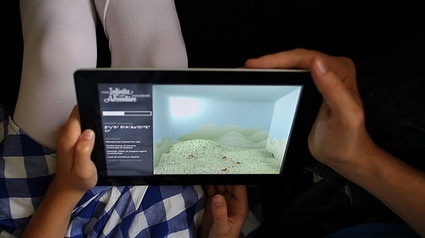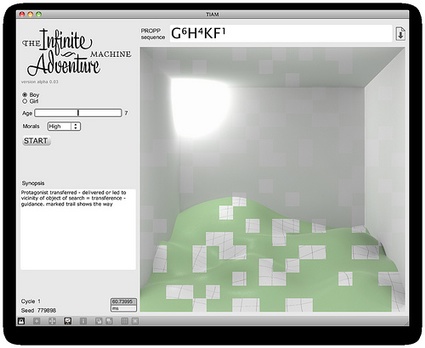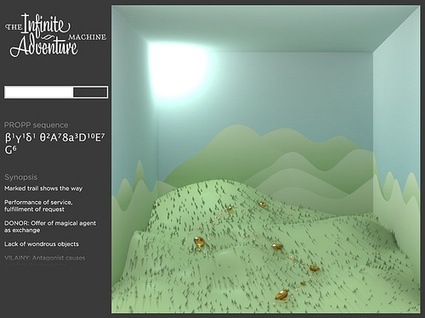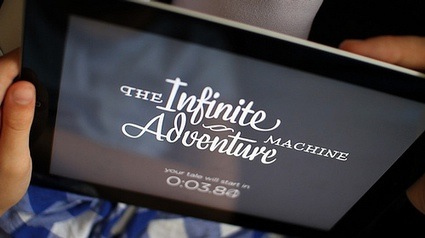
 The Infinite Adventure Machine is a proposal for a computer program which generates fairy-tale plots. The project explores the links between imagination and computation and investigates how the forms that tales and myths might take through digital formats and Artificial Intelligence.
The Infinite Adventure Machine is a proposal for a computer program which generates fairy-tale plots. The project explores the links between imagination and computation and investigates how the forms that tales and myths might take through digital formats and Artificial Intelligence.
Because the program is unable to deliver a finished story, rather only a crude synopsis and illustrations, users have to improvise, filling the gaps with their imagination and making up for the technology’s shortcomings.
Having watched the video demo above, i still had a number of questions for David Benque, the designer of The Infinite Adventure Machine.
Could you explain us how it works? What are the strange characters appearing on the left part of the screen and how are the images generated? Is there a way for the users to insert their own narratives and ideas inside the system? Or does it go in one way only?
TIAM is based on the work of Vladimir Propp, a structuralist who reduced Russian folk tales plots to 31 basic functions. Following this approach, you can imagine that it could be used backwards, to generate stories rather than analyse them. Each function is represented by a symbol or letter, with numbers specifying the sub-function. This means that a single tale can be expressed as a formula of ‘strange characters’.
 Formula of a tale called ‘The Swan Geese’ as synthesised by Propp
Formula of a tale called ‘The Swan Geese’ as synthesised by Propp
What the program does is pretty simple, it aggregates functions and their associated illustrations randomly, following a few simple rules, and presents them to the user with a timer so they have to interpret their meaning and connection to the previous ones, making up the story as they go along. Theoretically, all the plots that come out qualify as fairy tales, but in practice quite a lot of work is left to the humans.
In terms of input, the first interface had a few settings like boy/girl, age, and a mysterious ‘morals’ level (see image below). In the prototype I decided to focus on the ‘live’ interaction so the program only prompts the user without asking anything.
 The Infinite Adventure Machine is one of the first works i read about in which artificial intelligence collaborates with human intelligence in a meaningful way. I also like the fact that the work contradicts the idea that computer kills imagination and creativity in children.
The Infinite Adventure Machine is one of the first works i read about in which artificial intelligence collaborates with human intelligence in a meaningful way. I also like the fact that the work contradicts the idea that computer kills imagination and creativity in children.
But what is the state of artificial intelligence right now? Are we far far away from ELIZA? Could you name a few A.I. innovations that you found particularly inspiring for this project?
I’ve come across many examples of people attempting to program narrative. Most are funny at best, like the Arty Bollocks Generator (pardon my french) because of the randomness of what comes out. On one hand you have machines with more or less complex systems driving them, and on the other there are humans who are very good at making stories out anything that comes their way, it’s how we function. I love this quote from Joseph Gold “Story is to human beings what the pearl is to oysters, active adaptation.”
What is striking with things like ELIZA, and more recently Cleverbot, is how willing we are to interact with them. In this great radio show Sherry Turkle explains how some people working on ELIZA spent hours confessing to this very crude program, even though they knew how it worked! Similarly with Cleverbot, Rollo Carpenter and his team have noticed users spending way more time than expected engaging with the machine. In the case of Cleverbot it is slightly more ambiguous whether you might actually be speaking to someone, because it ‘learns’ from user input. However, when I tried to read it a bedtime story during my research it was pretty obvious that it wasn’t a person.
From what I gather, AI for video games is a big interest for researchers today. As authors are dealing with non-linear worlds and environments, it is much harder to think of everything. Authoring might become more about creating a system, a world in which your ‘readers’ are immersed and can explore according to the rules you set, as opposed to writing every single word. I see this more as an addition though, not a replacement for storytelling as we know it.

 The text describing your project states that “TIAM aims to question the limitations and implications of attempts at programming language and narrative.” What are the limitations you’re referring to?
The text describing your project states that “TIAM aims to question the limitations and implications of attempts at programming language and narrative.” What are the limitations you’re referring to?
One of my references while working on TIAM was The Diamond Age, A Young Lady’s Illustrated Primer by Neal Stephenson. In the book, a little girl is given a ‘magical’ book which adapts and reacts to her needs and experiences and becomes a kind of mentor to her. What is interesting is that although the story involves a lot of crazy nanotechnology, Stephenson invented a new kind of actors, human ‘ractors’ which control the book and other experiences from a sort of distant call-centre, making dialogues and so on. So even in the wildest future speculation, he still didn’t believe that machines would be able to tell stories on their own.
It is quite reassuring to think that everything in the world can be reduced to a system and therefore programmed. In a completely different field, Synthetic Biology is another example of this. However it often seems like something escapes us in that process, we end up creating wildly simplified, and limited versions of what we want to replicate and control. The mysterious and poetic aspects of narrative, what makes them so useful to us, were missing from any program output I’ve seen. So even if Propp’s work is fascinating, I wanted people to question the extent to which reducing stories to a system is a meaningful quest, and what part of our brains will remain an enjoyable mystery.
Do you think that The Infinite Adventure Machine is something that everyone could enjoy? Because i’d be intimidated by it. My lack of imagination and laziness have no equal on this planet but i could see that some people would feel extremely stimulated by that work. Where do you see that your project could end up? Battles of creativity between teams of improvised narrators? Or just a normal family game that could replace Monopoly and Cluedo?
I chose fairy tales because they are a good example of stories with a function: the transition from childhood to adulthood. So I imagine this being used by children and/or parents, for example as a bedtime story. It could also be a family game, although there is no scoring system.
The important thing is that it’s a computer program which prompts creativity and interaction between people, so it could work in different situations. Someone from an children improvisation theatre in the US got in touch, and they are interested in using TIAM in their shows. It is not quite ready for that yet, but fairy tale battles on stage might indeed be happening in the near future!
Have people tested The Infinite Adventure Machine? What was the outcome?
I did run some tests, one of which is documented in the video, which is live improvisation. I was surprised how good Matt and Tilly were at improvising on the spot, and things became even more interesting when they each did half of the story, as they had to deal with the other’s input as well as the program.
Will the visitors of the Glitch Fiction exhibition be able to try it out in a few days when you show it at the Paris Design Week?
Yes, I will have a few test stories for people to try, I will also be showing the improvisation video so the more ‘lazy’ visitors can see both sides of the interaction.
Thanks David!

All images courtesy of David Benque.
The Infinite Adventure Machine is a speculative project commissioned by Microsoft Research, Cambridge UK, Microsoft Office Team, Design Interactions, Royal College of Art, London UK as part of the Future of Writing project.
The Infinite Adventure Machine is going to be part of Glitch Fiction, a collective exhibition curated by Nelly Ben-Hayoun.The show will be held at the Cité de la Mode et du Design during Paris Design Week, 12-18 Sept. 2011.
